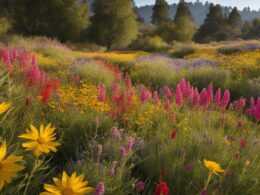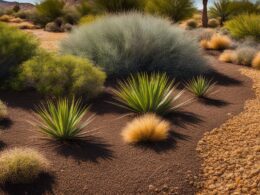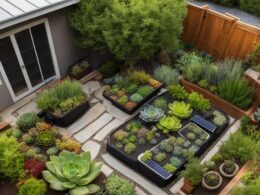Are you looking to create a beautiful and water-wise landscape in your dry climate garden? Choosing the right perennials is key to achieving a thriving and low-maintenance garden that can withstand drought conditions. In this practical guide, we will explore a selection of perennials that are perfectly suited for dry climates.
Key Takeaways:
- Choosing drought-tolerant perennials is essential for creating a thriving garden in a dry climate.
- Water-wise landscapes require minimal supplemental irrigation and help conserve water.
- Perennials like yarrow, blanket flowers, agastache, and lavender are excellent choices for dry climate gardens.
- These plants attract pollinators and resist deer and rabbit damage, adding beauty and biodiversity to your garden.
- Xeriscaping and using water-wise plants can save you money on water bills and contribute to a sustainable environment.
Now, let’s delve into the fascinating world of these thriving perennials for your dry climate garden and discover their unique characteristics and benefits.
Achillea Varieties: Beautiful and Heat-Tolerant Perennials
Achillea, also known as yarrow, is a tough and easy-growing perennial that thrives in full sun and well-drained soil. It comes in a variety of colors, including yellow, orange, red, pink, and white blooms. These vibrant flowers make great cut flowers and attract pollinators. Achillea varieties are drought-tolerant, reaching a size of up to 3 feet tall and wide. They are suited for zones 3-9.
If you’re looking for beautiful and heat-tolerant perennials for your dry climate garden, Achillea varieties are an excellent choice. Their vibrant blooms and low-maintenance nature make them a favorite among gardeners. Whether you prefer the sunny yellow hues or the striking red and orange colors, there is an Achillea variety to suit your taste.
One of the standout features of Achillea varieties is their ability to tolerate heat and drought. These plants have adapted to thrive in dry conditions, making them a perfect fit for water-wise landscapes. By planting Achillea in your garden, you can conserve water and still enjoy a stunning display of color throughout the summer.
In addition to their beauty, Achillea varieties are also highly attractive to pollinators, such as butterflies and bees. These flowers provide a valuable food source for these beneficial insects, helping to support a healthy ecosystem in your garden. So not only will you be adding visual appeal to your outdoor space, but you’ll also be doing your part to support local wildlife.
Gaillardia Varieties: Colorful and Hardy Blanket Flowers
Gaillardia, also known as blanket flower, is a tough and hardy perennial that adds a burst of vibrant color to dry climate gardens. These varieties offer not only stunning blooms but also excellent tolerance to drought conditions. Their ability to thrive in full sun and well-drained soil makes them a perfect choice for water-wise landscapes.
With their striking shades of red and yellow, gaillardia varieties are sure to catch the eye and bring life to any garden. Their flowers bloom all summer and into fall, providing a constant display of beauty. These plants are also attractive to pollinators, such as bees and butterflies, adding to the biodiversity of your garden.
“Gaillardia varieties are known for their hardiness and can withstand challenging weather conditions. These plants can adapt to fluctuating temperatures and are resistant to deer and rabbit damage.”
Reaching a size of up to 2 feet tall, gaillardia varieties are compact and versatile. They can be used as border plants, in rock gardens, or as part of a colorful wildflower meadow. Their low maintenance nature and ability to thrive in adverse conditions make them a reliable choice for any gardener.
Summary:
Gaillardia varieties are colorful and hardy blanket flowers that thrive in dry climate gardens. These drought-tolerant perennials display vibrant shades of red and yellow, blooming all summer and attracting pollinators. With their ability to withstand fluctuating temperatures and resist deer and rabbit damage, gaillardia varieties are a reliable choice for water-wise landscapes.
Penstemon Pinifolius: Scarlet-Red Beauties for Dry Gardens
Drought-tolerant perennials are a must-have for dry climate gardens, and Penstemon pinifolius is no exception. Also known as the semi-evergreen penstemon, these scarlet-red beauties add a burst of color to any garden. With their striking flowers and ability to thrive in challenging conditions, Penstemon pinifolius is a popular choice for water-wise landscapes.
One of the standout features of Penstemon pinifolius is its ability to attract butterflies and hummingbirds. These pollinators are drawn to the vibrant scarlet-red flowers, making your garden come alive with movement and color. The long blooming period of this perennial ensures that you’ll enjoy their beauty throughout the summer.
When it comes to cultivation, Penstemon pinifolius is relatively low-maintenance. This drought-tolerant plant prefers full sun and well-drained soil, making it an excellent choice for dry gardens. With a height of up to 18 inches, it can fit seamlessly into various garden designs. This perennial is hardy in zones 4-10, so it can thrive in a range of climates and regions.
A Comparison of Different Penstemon Varieties
| Variety | Height | Hardiness Zones | Flower Color |
|---|---|---|---|
| P. pinifolius ‘Compactum’ | 8-10 inches | 5-10 | Scarlet-red |
| P. pinifolius ‘Mersea Yellow’ | 8-10 inches | 5-10 | Yellow |
| P. pinifolius ‘Nearly Red’ | 8-12 inches | 5-10 | Red-orange |
As seen in the table above, there are different Penstemon pinifolius varieties to choose from, each with its own unique characteristics. Whether you prefer the classic scarlet-red flowers or want to experiment with other colors like yellow or red-orange, there’s a Penstemon pinifolius variety to suit your taste.
In conclusion, Penstemon pinifolius is a stunning drought-tolerant perennial that brings vibrant color and attracts pollinators to dry gardens. With its scarlet-red flowers, low-maintenance nature, and ability to thrive in challenging conditions, it’s an excellent choice for water-wise landscapes. Consider adding Penstemon pinifolius to your garden to create a beautiful and sustainable oasis.
Agastache Varieties: Colorful and Hummingbird Magnet
Agastache is a versatile perennial that blooms throughout the summer and autumn, adding a vibrant pop of color to your dry climate garden. With its beautiful flowers and attractive foliage, agastache varieties are sure to become a favorite among hummingbirds.
These drought-tolerant perennials thrive in full sun and well-drained soil, making them an excellent choice for water-wise gardening. They can reach a height of up to 3 feet, creating a stunning focal point in your landscape.
One popular variety, ‘Desert Sunrise’, features orange blooms with pink and lavender tints. This stunning combination of colors is irresistible to hummingbirds, making your garden a hub of activity. The long-lasting blooms of agastache varieties ensure that you will enjoy their beauty throughout the season.
So, if you want to attract hummingbirds and add a splash of color to your dry climate garden, consider planting agastache varieties. With their vibrant blooms, drought-tolerant nature, and ability to thrive in full sun, these perennials are a must-have for any water-wise landscape.
| Agastache Varieties | Bloom Color | Height | Hardiness Zones |
|---|---|---|---|
| ‘Desert Sunrise’ | Orange with pink and lavender tints | Up to 3 feet | Zones 5-10 |
| ‘Blue Fortune’ | Purple-blue | Up to 3 feet | Zones 5-10 |
| ‘Golden Jubilee’ | Yellow | Up to 3 feet | Zones 5-10 |
Sedum ‘Autumn Joy’: Drought-Resistant Beauty for Dry Gardens
Sedum ‘Autumn Joy’ is a stunning perennial that adds beauty and resilience to any dry garden. With its fleshy leaves and vibrant blooms, this drought-resistant plant is a standout choice for water-wise landscapes. The succulent nature of its leaves allows it to retain water, making it well-suited for arid climates. The ‘Autumn Joy’ variety is particularly popular for its ability to thrive in full sun and well-drained soil. It reaches a height of up to 18 inches, making it a versatile option for borders, rock gardens, or containers.
The Sedum ‘Autumn Joy’ is known for its stunning clusters of pink flowers that mature into a deep red shade, adding a pop of color to your garden. These blooms attract butterflies and bees, creating a vibrant and lively atmosphere. As an additional benefit, the ‘Autumn Joy’ variety has variegated foliage that adds visual interest even when it’s not in bloom. Its elegant and compact growth habit makes it a low-maintenance choice that requires minimal supplemental irrigation.
To incorporate Sedum ‘Autumn Joy’ into your garden, ensure you provide it with a sunny spot and well-drained soil. This hardy perennial is suitable for zones 3-9, making it adaptable to various regions across the United States. Sedum ‘Autumn Joy’ pairs well with other drought-resistant perennials in a xeriscape garden or can be used as a focal point in a flower bed. With its unique foliage and vibrant flowers, Sedum ‘Autumn Joy’ is a beautiful addition to any dry garden.
Drought-Resistant Perennials for Dry Gardens
- Sedum ‘Autumn Joy’: This succulent perennial with fleshy leaves and vibrant pink to red blooms is a standout drought-resistant beauty for dry gardens.
- Achillea Varieties: These heat-tolerant perennials come in a range of colors and attract pollinators while thriving in arid climates.
- Gaillardia Varieties: Blanket flowers offer vibrant shades of red and yellow, blooming all summer and into fall in dry gardens.
- Agastache Varieties: Colorful and hummingbird magnets, agastache thrives in dry gardens while adding beauty and attracting pollinators.
- Penstemon Pinifolius: Scarlet-red beauties that are drought-tolerant and loved by butterflies and hummingbirds.
Choose Sedum ‘Autumn Joy’ and other drought-resistant perennials to create a water-wise landscape that thrives even in dry conditions. Their ability to conserve water and attract pollinators makes them a perfect choice for environmentally friendly and low-maintenance gardens.
| Plant | Height | Bloom Color | Suitability Zones |
|---|---|---|---|
| Sedum ‘Autumn Joy’ | Up to 18 inches | Pink to red | Zones 3-9 |
| Achillea Varieties | Up to 3 feet | Various colors | Zones 3-9 |
| Gaillardia Varieties | Up to 2 feet | Red and yellow | Zones 3-8 |
| Agastache Varieties | Up to 3 feet | Various colors | Zones 5-10 |
| Penstemon Pinifolius | Up to 18 inches | Scarlet-red | Zones 4-10 |
Perovskia Atriplicifolia: A Tough and Drought-Resistant Perennial
Perovskia atriplicifolia, commonly known as Russian sage, is a stunning perennial that thrives in dry climates. With its beautiful silvery foliage and tall violet-purple blooms, this plant adds both color and texture to any garden. Russian sage is an excellent choice for those looking to create a low-maintenance, water-wise landscape while still enjoying vibrant flowers and attracting pollinators.
This drought-tolerant perennial is incredibly tough and can withstand harsh conditions. It thrives in full sun and well-drained soil, making it an ideal choice for dry gardens. Russian sage can reach an impressive height of up to 6 feet, making it perfect for the back of the border or as a focal point in the garden. Its airy appearance and elegant flowers create a sense of movement, adding a touch of grace to the landscape.
Not only is Russian sage resistant to drought, but it also attracts pollinators like bees and butterflies. The vibrant purple blooms act as a magnet, bringing life and activity to your garden. Additionally, its foliage emits a pleasant fragrance when brushed against, adding an extra sensory appeal to your outdoor space. Whether you’re creating a butterfly garden or simply want to enjoy the beauty of nature, Russian sage is an excellent addition to any dry climate garden.
Benefits of Perovskia Atriplicifolia:
- Drought-tolerant: Russian sage is highly adapted to dry conditions, making it an excellent choice for water-wise gardens.
- Attracts pollinators: The vibrant purple blooms of Russian sage attract bees and butterflies, enhancing biodiversity in your garden.
- Low-maintenance: Once established, Russian sage requires minimal care, making it an ideal choice for busy gardeners.
- Tall and elegant: With its impressive height and airy appearance, Russian sage adds vertical interest and a sense of movement to your garden.
- Beautiful foliage: The silver-gray leaves of Russian sage provide a striking contrast to other plants in the garden and emit a pleasant fragrance when touched.
Incorporating Perovskia atriplicifolia into your dry climate garden will not only add beauty and charm but also contribute to the sustainability of your landscape. Its ability to thrive in challenging conditions while attracting pollinators makes it a valuable asset to any garden. Embrace the resilience and elegance of Russian sage and enjoy a flourishing garden that withstands the test of time.
| Variety | Height | Hardiness | Bloom Color |
|---|---|---|---|
| Russian Sage ‘Little Spire’ | 2-3 feet | Zones 4-9 | Purple |
| Russian Sage ‘Blue Jean Baby’ | 3-4 feet | Zones 4-9 | Purple |
| Russian Sage ‘Longin’ | 4-5 feet | Zones 4-9 | Purple |
Salvia Varieties: Colorful and Drought-Resistant Perennials
Salvias are a diverse group of perennials that offer a wide range of colors and characteristics. These beautiful plants not only add vibrant splashes of color to your garden but also thrive in dry climates. With their ability to withstand drought conditions, salvias are an excellent choice for water-wise landscaping. What’s more, their nectar-rich flowers make them a magnet for hummingbirds, adding a delightful touch of wildlife to your outdoor space.
Salvia Varieties: A Bounty of Choices
There are numerous salvia varieties to choose from, each with its own unique characteristics. Whether you prefer bold, showy blooms or delicate, compact plants, there is a salvia variety to suit your taste. Some popular options include:
- Salvia ‘Raspberry Delight’: This stunning variety produces vibrant, deep pink flowers that add a pop of color to any garden.
- Salvia ‘May Night’: Known for its rich purple-blue flowers, this variety attracts both hummingbirds and butterflies.
In addition to their visual appeal, salvias are renowned for their resilience. These drought-resistant perennials can thrive in full sun and well-drained soil, making them perfect for xeriscaping projects. With their ability to conserve water and still produce an abundance of blooms, salvias are an eco-friendly choice for any garden.
“Salvias are not only beautiful, but they are also incredibly low-maintenance. Their ability to withstand dry conditions and still produce stunning flowers makes them a must-have for any water-wise garden.”
Creating a Hummingbird Haven
One of the greatest attractions of salvias is their ability to attract hummingbirds. These tiny, vibrant birds are a joy to watch as they flit from flower to flower, sipping nectar. By incorporating salvias into your garden, you can create a hummingbird haven and enjoy the delightful presence of these winged wonders.
Planting salvias in clusters or groups will make them more visible to hummingbirds and increase the chances of attracting these delightful creatures. Combine different varieties and colors to create an eye-catching display that will not only please the eye but also provide a reliable food source for hummingbirds.
So, whether you’re looking to add a splash of color to your garden or attract hummingbirds to your yard, salvias are the perfect choice. With their drought-resistant nature, easy care requirements, and stunning blooms, they are a must-have for any water-wise landscape.
Lavandula Angustifolia: Fragrant and Drought-Tolerant Perennial
Lavandula angustifolia, commonly known as lavender, is a highly sought-after perennial for its stunning beauty and fragrant flowers. This versatile plant is not only visually appealing but also a great addition to dry climate gardens due to its excellent drought tolerance. Lavandula angustifolia is a reliable choice for those looking to create a water-wise landscape without compromising on aesthetics.
One of the key features of Lavandula angustifolia is its delightful fragrance. The flowers emit a calming and soothing scent that can transform your garden into a fragrant oasis. Whether used in fresh flower arrangements or dried for potpourri and crafts, the aromatic blooms of Lavandula angustifolia add a touch of elegance and natural perfume to any setting.
| Key Features of Lavandula angustifolia | Details |
|---|---|
| Drought Tolerance | Thrives in dry conditions, requiring minimal supplemental irrigation. |
| Fragrance | Produces a delightful and calming scent that fills the air. |
| Height | Reaches a height of approximately 3 feet, making it an ideal choice for the middle or back of flower beds. |
| Hardiness | Well-suited for zones 5-8, with the ability to withstand colder climates. |
| Uses | Perfect for flower arrangements, potpourri, crafts, and as a natural pest repellent. |
To successfully cultivate Lavandula angustifolia, it is crucial to provide it with full sun exposure and well-drained soil. These conditions mimic its natural habitat in the Mediterranean region, ensuring optimal growth and flower production. Lavandula angustifolia is a hardy perennial that can withstand various soil types, as long as they are well-draining, preventing root rot and other moisture-related issues.
With its stunning purple, pink, or white flowers and its enchanting fragrance, Lavandula angustifolia is a must-have perennial for dry climate gardens. Not only does it bring visual appeal and aromatic beauty, but it also contributes to the overall sustainability of your landscape by reducing the need for excessive watering. Incorporate Lavandula angustifolia into your garden and enjoy its charm, fragrance, and remarkable resilience against drought conditions.
“The fragrance of lavender is aromatic bliss, transforming any garden into a sensory haven.” – Unknown
Conclusion
By selecting the right perennials for dry climate gardens, you can create a thriving and water-wise landscape. Native and drought-tolerant plants, such as yarrow, blanket flowers, agastache, and lavandula angustifolia, are excellent choices. These plants require minimal supplemental irrigation and attract pollinators while resisting deer and rabbit damage. Embracing xeriscaping and the use of water-wise plants is not only environmentally friendly but also cost-effective. Start transforming your garden into a sustainable oasis today.
FAQ
What are perennials for dry climate gardens?
Perennials for dry climate gardens are plants that are adapted to thrive in low water conditions. These plants have developed mechanisms to withstand drought and require less supplemental irrigation.
Why should I choose perennials for dry climate gardens?
By selecting perennials that are adapted to dry conditions, you can create a water-wise landscape that requires less maintenance and reduces water consumption. These plants can survive and thrive with minimal supplemental irrigation.
What are the benefits of selecting drought-tolerant perennials?
Drought-tolerant perennials are low-maintenance, meaning they require less watering and care. They also attract pollinators, such as butterflies and hummingbirds, while resisting damage from deer and rabbits.
How do I know if a perennial is suitable for a dry climate garden?
Look for perennials that are labeled as drought-tolerant or xeric. These plants are specifically bred or selected for their ability to thrive in low water conditions. Additionally, consider the plant’s native habitat and natural adaptations to determine if it is well-suited for your dry climate garden.
Can I grow perennials for dry climate gardens in containers?
Yes, many drought-tolerant perennials can be grown successfully in containers. Use well-draining soil and select compact varieties that are suitable for container gardening. Be mindful of the container size and ensure it is large enough to accommodate the plant’s root system.
How often should I water perennials for dry climate gardens?
Once established, perennials for dry climate gardens typically require watering once every 1-2 weeks, depending on rainfall and temperature. Monitor the soil moisture and water when the top couple of inches feel dry. It’s better to water deeply and infrequently rather than shallowly and frequently.
Can I use mulch around perennials for dry climate gardens?
Yes, mulch can be beneficial for perennials in dry climate gardens. Apply a layer of organic mulch, such as wood chips or straw, around the base of the plants to help retain soil moisture, suppress weeds, and regulate soil temperature.
How should I prepare the soil for planting perennials in a dry climate garden?
Before planting, amend the soil with organic matter, such as compost or well-rotted manure, to improve soil structure and water-holding capacity. Ensure the soil is well-draining to prevent waterlogging, which can be detrimental to drought-tolerant perennials.
Can I use fertilizers on perennials for dry climate gardens?
It is generally recommended to avoid excessive fertilization for perennials in dry climate gardens. These plants are adapted to survive in nutrient-poor conditions and may not require frequent feeding. If necessary, use a slow-release fertilizer or organic options in moderation.
How do I maintain perennials for dry climate gardens?
Once established, perennials for dry climate gardens are generally low-maintenance. Regularly remove weeds around the plants to reduce competition for water and nutrients. Prune as needed to maintain shape and remove dead or damaged growth. Monitor for pests and diseases, and take appropriate action if necessary.














